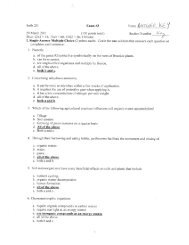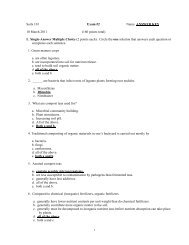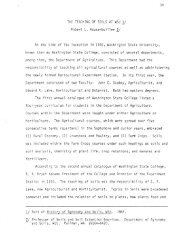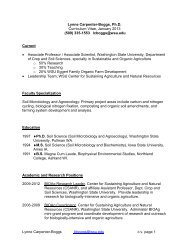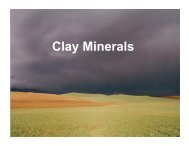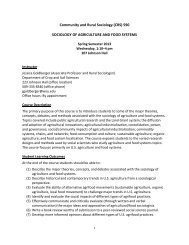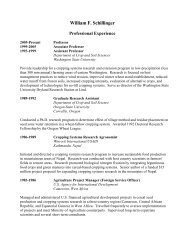2012 Dryland Field Day Abstracts - Dept. of Crop and Soil Sciences ...
2012 Dryland Field Day Abstracts - Dept. of Crop and Soil Sciences ...
2012 Dryland Field Day Abstracts - Dept. of Crop and Soil Sciences ...
Create successful ePaper yourself
Turn your PDF publications into a flip-book with our unique Google optimized e-Paper software.
Page 62<br />
<strong>2012</strong> <strong>Field</strong> <strong>Day</strong> <strong>Abstracts</strong>: Highlights <strong>of</strong> Research Progress<br />
to 160 lb N/acre with 15 lb S/acre). Fall-spring split applications <strong>of</strong> N, <strong>and</strong> select N fertilizer treatments with no added S are also<br />
included.<br />
Residual inorganic soil N was low at both locations in 2011, 73 lb N/acre at the Wilke Farm <strong>and</strong> 103 lb N/acre at PCFS. Spring<br />
canola grain yields at PCFS were higher than in previous years, <strong>and</strong> therefore more responsive to N fertilizer additions (see graph).<br />
No consistent yield responses to S additions were<br />
observed. The economically optimum N rate (at $0.22/<br />
lb canola <strong>and</strong> $0.56/lb N as urea) at the Wilke Farm was<br />
69 lb N/acre, while at PCFS it was determined that no N<br />
fertilizer added under these yield response <strong>and</strong> price<br />
scenarios paid for itself.<br />
Fig. 1. Canola seed yield response to N supply at Pullman (PCFS) <strong>and</strong><br />
Davenport (Wilke). The left-most plotted point on each response<br />
curve represents 0 N fertilizer applied.<br />
Establishing Switchgrass for Bi<strong>of</strong>uel in the North Columbia Basin<br />
Steve Fransen, WSU-Prosser IAREC<br />
The four year N x S fertility experiment indicates that<br />
accurate estimation <strong>of</strong> soil N supply <strong>and</strong> canola yield<br />
potential is critical in determining proper N fertilization<br />
rates. In recognition that canola can aggressively utilize<br />
residual soil N supplies if available, N fertilizer rates<br />
should be reduced when residual soil N is present. In<br />
addition, canola returns significant crop residue N to<br />
the soil following harvest. Thus, we have exp<strong>and</strong>ed the<br />
study in <strong>2012</strong> to follow the carryover N from canola<br />
residues <strong>and</strong> its effects on subsequent legumes <strong>and</strong><br />
wheat grown in rotation. This research is leading<br />
towards a modification <strong>of</strong> existing regional guidelines<br />
for canola fertility management with a goal <strong>of</strong><br />
maximizing yield <strong>and</strong> oil productivity.<br />
Switchgrass bi<strong>of</strong>uel research started at WSU in 2002 in Prosser after observing irrigated circles <strong>of</strong> switchgrass seed produced by<br />
Rainier Seed Company in 2001. This project was initiated to investigate new ‘windows’ for successful establishment <strong>of</strong> switchgrass<br />
in the Columbia Basin <strong>and</strong> to evaluate long term storage <strong>of</strong> switchgrass hay for bioenergy conversion. Cellulosic biorefineries will<br />
operate daily for about eleven months per year. <strong>Crop</strong>s cannot be harvested continuously over this time so the feedstock will<br />
require storage.<br />
Date <strong>of</strong> planting studies were conducted at WSU-Othello in 2008 <strong>and</strong> 2009 <strong>and</strong> a study evaluating long-term storage as dry or high<br />
moisture hay was initiated at Othello in 2008 intending for two complete grass hay harvests in 2009, 2010 <strong>and</strong> 2011. These are<br />
the first hay results from a lowl<strong>and</strong> switchgrass (Kanlow) or Eastern Gamagrass (Nemaha) from as far north as WSU-Othello (46°<br />
N). Results confirm that warm season grass hay can be consistently produced in the northern Columbia Basin region.<br />
This study will conclude after the post-storage hay bales are processed <strong>and</strong> NIRS scanning completed on cored samples. Our<br />
studies will provide four years <strong>of</strong> data that can be used in developing guidelines for long term storage. Results from the date <strong>of</strong><br />
planting studies have been incorporated into a switchgrass production Extension bulletin that is expected to be published in <strong>2012</strong>.<br />
Extension <strong>and</strong> Outreach Activities<br />
Karen Sowers, Dennis Roe, Bill Pan, <strong>and</strong> Deb Marsh; <strong>Dept</strong>. <strong>of</strong> <strong>Crop</strong> <strong>and</strong> <strong>Soil</strong> <strong>Sciences</strong>, WSU<br />
The Washington State Bi<strong>of</strong>uels <strong>Crop</strong>ping Systems Research <strong>and</strong> Extension Project (WBCS) has been funded since 2007, <strong>and</strong> has<br />
included 15-20 projects, 18 principal investigators, 12 collaborators, <strong>and</strong> nearly 50 agency <strong>and</strong> university affiliates, technicians,<br />
<strong>and</strong> graduate students. Written <strong>and</strong> online publications; a dedicated website; <strong>and</strong> presentations at workshops, field days, <strong>and</strong>




